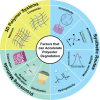Biodegradable Polyesters: Approaches to Increase Degradation Rates for Biomedical Applications
- PMID: 40783929
- PMCID: PMC12369017
- DOI: 10.1021/acsmacrolett.5c00417
Biodegradable Polyesters: Approaches to Increase Degradation Rates for Biomedical Applications
Abstract
The rate of biodegradation of polyesters is essential to their utility in biomedical applications but is frequently undesirably slow, prompting significant interest in overcoming this limitation. Herein, we highlight passive, enzyme-mediated, and load-mediated mechanisms of the hydrolytic degradation of polyesters. Exemplified by recent reports, strategies to impart accelerated rates of degradation are discussed, including synthetic routes, 3D systems, and processing methods. Approaches to assess polyester degradation in vitro and in vivo are summarized, underscoring the need for careful consideration of testing parameters and the challenges arising from testing variability employed within the reported literature. Recent reports also highlight faster-degrading polyester systems for targeted biomedical applications, including regenerative engineering, drug delivery, women's health, and other medical devices. Overall, polyesters with accelerated rates of degradation will afford tremendous opportunities in bioresorbable devices and therapeutics.
Figures




References
-
- Low Y. J., Andriyana A., Ang B. C., Abidin N. I. Z.. Bioresorbable and degradable behaviors of PGA: Current state and future prospects. Polym. Eng. Sci. 2020;60:2657–2675. doi: 10.1002/pen.25508. - DOI
-
- Morsada Z., Hossain M. M., Islam M. T., Mobin M. A., Saha S.. Recent progress in biodegradable and bioresorbable materials: From passive implants to active electronics. Appl. Mater. Today. 2021;25:101257. doi: 10.1016/j.apmt.2021.101257. - DOI
-
- Larrañaga A., Lizundia E.. A review on the thermomechanical properties and biodegradation behaviour of polyesters. Eur. Polym. J. 2019;121:109296. doi: 10.1016/j.eurpolymj.2019.109296. - DOI
Publication types
MeSH terms
Substances
Grants and funding
LinkOut - more resources
Full Text Sources

